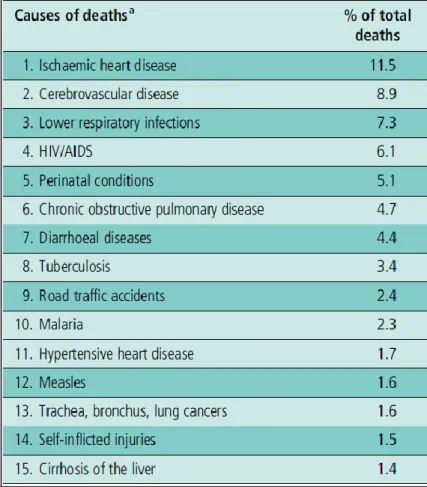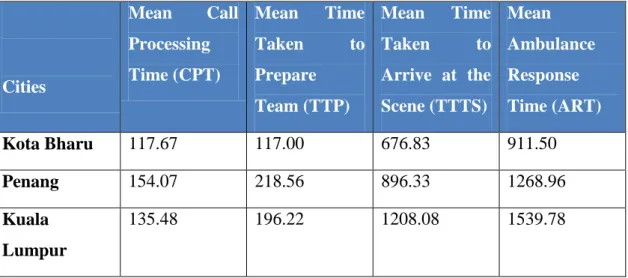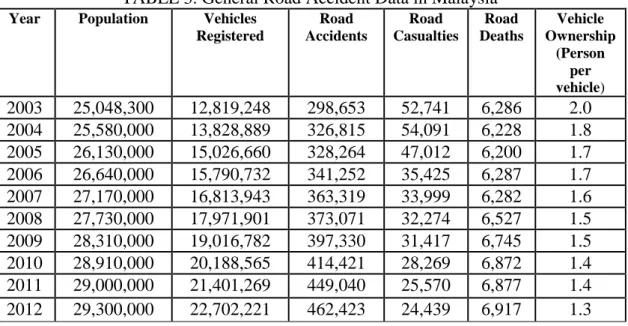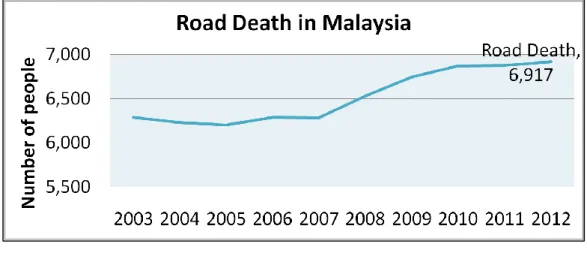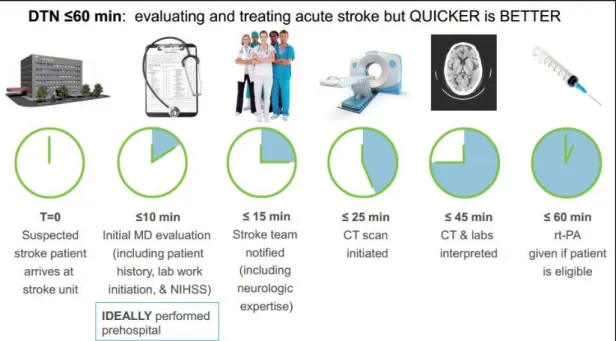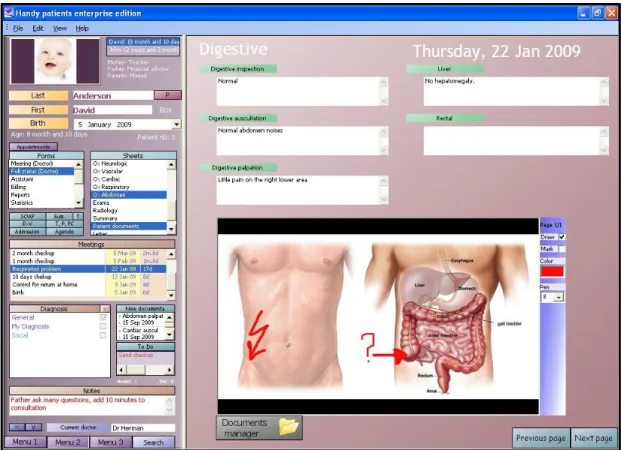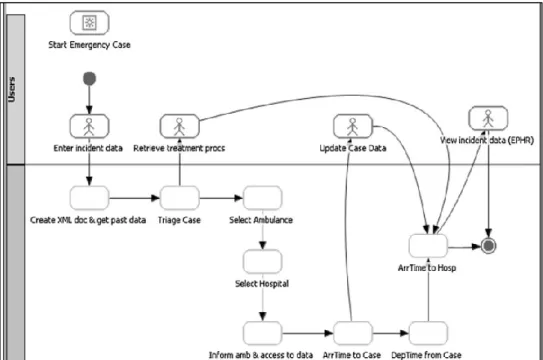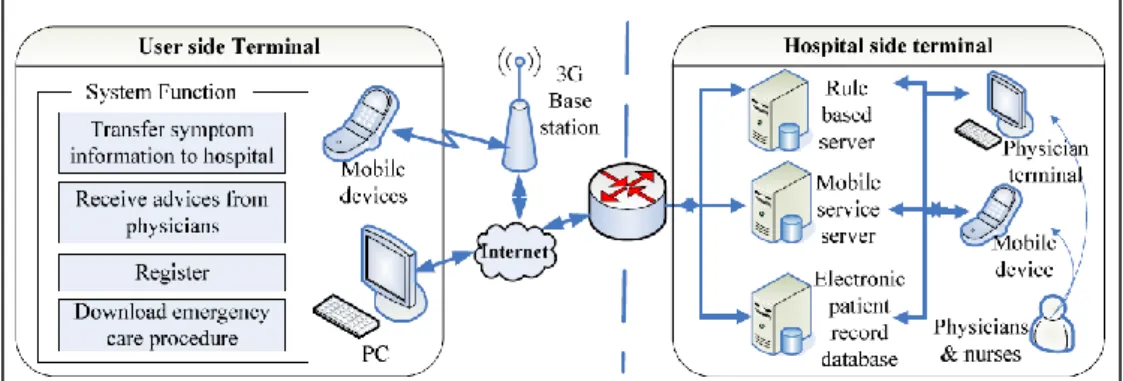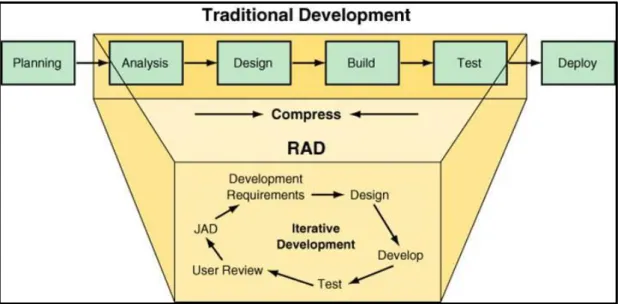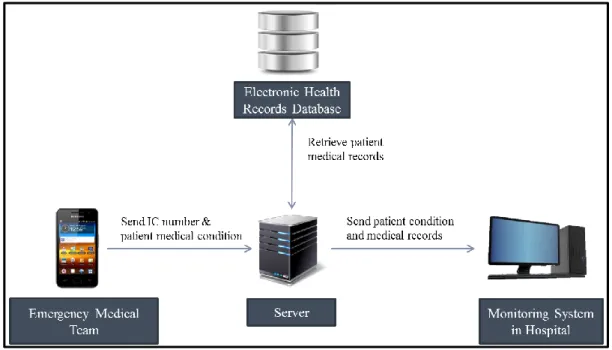Pre-hospital Emergency Notification System
by
Foo Kian Xiong
Dissertation submitted in partial fulfilment of the requirements for the
Bachelor of Technology (Hons) (Information & Communication Technology)
MAY 2014
Universiti Teknologi PETRONAS Bandar Seri Iskandar
31750 Tronoh
Perak Darul Ridzuan
CERTIFICATION OF APPROVAL
Pre-hospital Emergency Notification System
by
Foo Kian Xiong
A project dissertation submitted to the
Information & Communication Technology Programme Universiti Teknologi PETRONAS
in partial fulfillment of the requirement for the BACHELOR OF TECHNOLOGY (Hons)
(INFORMATION COMMUNICATION TECHNOLOGY)
Approved by,
_____________________
ALIZA BINTI SARLAN
UNIVERSITI TEKNOLOGI PETRONAS TRONOH, PERAK
MAY 2014
________________________
ENA BHATTACHARYYA
CERTIFICATION OF ORIGINALITY
This is to certify that I am responsible for the work submitted in this project, that the original work is my own except as specified in the references and acknowledgements, and that the original work contained herein have not been undertaken or done by unspecified sources or persons.
_____________________
FOO KIAN XIONG
ABSTRACT
The number of death cases is increasing annually due to the increasing number of population in the country while the quality of medical healthcare is not progressing fast enough to ensure the quality of life. One of the factor causes the mortality of people is the lack of appropriate pre-hospital care provided. The effectiveness of pre-hospital care is important to reduce the death risk of severe cases like road accident and heart attack. The author proposes a mobile application which allows the emergency medical team to notify the hospital about the incoming victim’s personal information and medical condition. It also provides a web-based system used by hospital staff to view the incoming victims. Rapid Application Development is used in this project. The prototype has been developed using App Inventor 2, PHP and MYSQL. A mock-up database of the victim personal information is stored in MYSQL.
ACKNOWLEDGEMENT
First and foremost, it is an honor to express my deeply sincere gratitude to my supervisor, Miss Aliza Binti Sarlan and my co-supervisor, Miss Ena Bhattacharyya for their kind help, support and encouragement during final year in order to complete this project. Certainly my project has been successful. They have not only served as a supervisor but also patiently guided me throughout the final year project process, and gave me precise and necessary advice when I need one.
Finally, I would like to extend my appreciation and faithful thanks to family and to all around me, whose name have not been mentioned, who either directly or indirectly have encouraged me to successfully complete this final year project and stand all challenges.
TABLE OF CONTENTS
CERTIFICATION i
ABSTRACT iii
ACKNOWLEDGEMENT iv
CHAPTER 1: INTRODUCTION 1
1.1 Background Study 1
1.2 Problem Statement 3
1.3 Objectives 4
1.4 Scope of Study 4
CHAPTER 2: LITERATURE REVIEW 5
2.1 Social Media 5
2.2 Pre-hospital Care and Its Importance 6 2.3 Importance of Pre-hospital Notification in
Road Accident 7
2.4 Importance of Pre-hospital Notification in Acute Ischemic Stroke Care 8
2.5 Electronic Health Records 9
2.6 Related Works 10
2.7 User Interface Design 12
CHAPTER 3: METHODOLOGY 13
3.1 Rapid Application Development (RAD) 13 3.2 System Architecture 15 3.3 Use Case Diagram 16 3.4 Gantt Chart and Key Project Milestone 17
CHAPTER 4: RESULTS AND DISCUSSION 19
4.1 System Flowchart 19 4.2 Android Mobile Application used by
Emergency Medical Team 20 4.3 Web-based System used by
Hospital Staff 28
4.4 Functional Testing 31
CHAPTER 5: CONCLUSION AND RECOMMENDATION 33
REFERENCE 35
APPENDIX 37
LIST OF FIGURES
Figure 1 Line Chart of Road Death in Malaysia 8
Figure 2 Ideal Door-to-needle Time 9
Figure 3 Handy Patients Enterprise Edition 10
Figure 4 Architecture of Mobile Emergency Healthcare Information System 11 Figure 5 The EMS Process Model 11 Figure 6 RAD Life Cycle 13
Figure 7 Overview of System Architecture 15
Figure 8 Use Case of Emergency Pre-hospital Notification System 16
Figure 9 System Flowchart of Pre-hospital Emergency Notification System 19
Figure 10 Screenshot of Screen 1 20
Figure 11 Screenshot of Screen 2 21
Figure 12 Screenshot of Screen 3 22
Figure 13 Screenshot of Screen 4 23
Figure 14 Screenshot of Screen 5 24
Figure 15 Screenshot of Screen 6 25
Figure 16 Screenshot of Screen 6 (continued) 26
Figure 17 Screenshot of Severity Indicator Section 27 Figure 18 Screenshot of homepage 28
Figure 19 Screenshot of Case 2 28
Figure 20 Screenshot of Case 2 (Continued) 29
Figure 21 Black-box Testing Model 31 LIST OF TABLES Table 1 Leading causes of death in middle income and low-income countries 2
Table 2 Mean Ambulance Response Time in Three Different Cities in Malaysia 7
Table 3 General Road Accident Data in Malaysia 7
Table 4 Mock-up Electronic Health Records in MYSQL 30
Table 5 Test Cases of Android Application 31
1
CHAPTER 1
INTRODUCTION
1. INTRODUCTION
1.1 Background of Study
Each year, there are approximately five millions of people worldwide die due to injuries(Holder & Organization, 2001). The 15 leading causes of death occurring among people aged between 5-44 years in 2002 are road traffic-related injuries, self- inflicted injuries, interpersonal violence, burns and drowning (Peden, McGee, &
Krug, 2002).The number of death is increasing every year due to the increasing number of population in the country and the lack of improvement in the quality of the emergency medical services (EMS) and healthcare. It indicates that the medical services in the country must be enhanced in order to cope up with this issue.
In general, the rates of death due to life-threatening injuries could be reduced by preventing them. However, some injuries caused are occasionally unavoidable so the best way to deal with these problems is to minimize the consequences of serious injury by providing effective pre-hospital care. A study has been done on the leading causes of death in middle income and low income countries(Razzak & Kellermann, 2002). It describes that the causes of death could be prevented by early intervention and they are highlighted with dark green background in Table 1. It shows that pre- hospital care is an important factor of reducing the risk of death.
2
TABLE 1. Leading causes of death in middle income and low-income countries
Deaths could be categorized into the types (Sasser, Varghese, Kellermann, &
Lormand, 2005). They could be either:
1. occur immediately or occur quickly as a result of overwhelming injury;
2. occur during the intermediate phase. These death occur within few hours of the event and are frequently the result of treatable conditions;
3. delayed. The death is occurred days or week after the initial injury and the result of infection, multisystem failure or other late complication of trauma.
Pre-hospital care is associated with the emergency medical services of the hospital.
The main purpose of pre-hospital care is to stabilize the victims who have a limb- threatening or life-threatening injury or illness. The fatality of injuries may be prevented or reduced by implementing a proper pre-hospital care. It is important to have an effective pre-hospital care but unfortunately Malaysia is still in an early phase of development (Hisamuddin, Hamzah, & Holliman, 2007).
3
However, the current pre-hospital care does not provide a good communication between emergency medical services team and the hospital. There is some delay on the medical decision-making when the victims reach the hospital. To overcome these problems, the author provides a solution to improve the pre-hospital care by developing pre-hospital notification system through Android mobile application. It allows emergency medical team to provide the detailed condition of the victims to the hospital so that the decision-making delay in hospital could be reduced.
1.2 Problem Statement
The following are the current problems faced by the pre-hospital care:
1) Ineffective communication between emergency medical team and hospital There is no proper communication path between these two parties. The hospital receives emergency calls from the public regarding the incidents and sends out emergency medical team to the incidents spot. The medical team will stabilize the patients and send them to the hospital immediately. However, the hospital does not have the updated medical condition regarding the incoming patients which will leads to some delay time on deciding further treatment when the victims reach the hospital. The emergency medical team might call the hospital to update the severity of the patients, but it might be difficult to manage for hospital which has high number of emergency cases.
2) Lack of effective pre-hospital notification system in Malaysia
As the pre-hospital care in Malaysia is still in an early development phase, there is still yet a proper pre-hospital notification system in Malaysia. The hospital is not notified by the incoming patients, and further treatment on the patient is usually being done when the patients reach the hospital.
3) Hospital has low accessibility of medical records of the victims.
One of the problem in current hospital information management system is that the medical records or diagnosis report of the patients are stored in a paper format. Those documents are difficult to be accessed if the patients are involved
4
in an emergency case when they are quite far from the hospital which holds their medical records.
1.3 Objective
To develop a pre-hospital emergency notification system, which consists of:
a) an Android mobile application that send the medical severity of road accident victims to the hospital
b) a web-based system at hospital end user for viewing received notification and victims information.
1.4 Scope of Study
1) The system is a mobile application which is developed using Android OS 2) The system is designed based on the pre-hospital system in Malaysia
3) The system assumed that there is already an existing database which stores all the medical records of all Malaysian.
4) The system assumed that there is an existing Electronic Health Records available.
5
CHAPTER 2
LITERATURE REVIEW
2. LITERATURE REVIEW
This literature review will explain the importance of the pre-hospital care internationally and in Malaysia. It will also describe the current existence of electronic health records in certain countries. Next, it will give details on the importance of implementing pre-hospital notification system towards certain acute illness like stroke and trauma.
2.1 Pre-hospital Care and Its Importance
Pre-hospital care is always referring to the emergency medical services (EMS) of a hospital. EMS is a type of emergency service which provides transportation for the patients from the incident to the hospital (Wikipedia, 2014). The main goal of this service is to stabilize the patients and prevent any further injury or infection happens to the patients.
There are 3 components in pre-hospital care (Razzak & Kellermann, 2002), which is:
1) Care in the community. The result of injury or acute illness is highly related to the early recognition of its severity and the necessity of medical intervention. Since majority of the emergencies occur at home, hence it is important that the community should cooperate with the hospital in order to reduce the risk of death of the patients.
2) Care during transportation. The absence of the emergency medical transport could also be the main factor causing the death of the patients. There might also be some few factors, including traffic congestion, lack of proper transport vehicle, and lack of effective communication between EMS and
6
hospital which causes the difficulty of early medical intervention. In Sierra Leone, the investment on an enhanced communication system and proper transport vehicles in the EMS led to a 50% decrease in case fatalities(Samai
& Sengeh, 1997).
3) Care on arrival at the receiving health facility. Another important factor concerning the risk of death is the availability of treatment on arrival at the hospital. Each hospital has different facilities level depending on their availability and capacity of equipment, staff and resources. A poor quality of hospital facilities will lead to poor consequences. In Malawi, most of the seriously ill children arriving at the clinic are not recognized in advance.
They were kept too long in waiting instead of be given a proper treatment. It resulted in an avoidable disability and deaths (Gove, Tamburlini, Molyneux, Whitesell, & Campbell, 1999).
2.2 Pre-hospital Care in Malaysia
Based on a study regarding the pre-hospital EMS in Malaysia (Hisamuddin et al., 2007), the current EMS team in both governmental and non-governmental bodies is manned by untrained personnel. They practice a “scoop and run” approach which do not contribute much on the stabilization process of the patient.
Recently, Universiti Sains Malaysia (USM), a local medical school has initialized the first Emergency Medical Dispatcher (EMD) program which contributes in the ambulance response time. In 2004, the ambulance response time has increased by roughly 44% after the initiation of EMD training program. Next, the program also increases the public awareness towards pre-hospital emergency care.
The average ambulance response time in Malaysia differs from one location to another (Table 2). The effectiveness of ambulance response time is depends on the crew mobilization time, emergency call processing time and travel time to scene.
Untrained providers, traffic congestion and poor communication can be the causes of delayed in response.
7
TABLE 2. Mean Ambulance Response Time in Three Different Cities in Malaysia
Cities
Mean Call Processing Time (CPT)
Mean Time Taken to Prepare Team (TTP)
Mean Time Taken to Arrive at the Scene (TTTS)
Mean Ambulance Response Time (ART)
Kota Bharu 117.67 117.00 676.83 911.50
Penang 154.07 218.56 896.33 1268.96
Kuala Lumpur
135.48 196.22 1208.08 1539.78
* Mean time in seconds. ART = CPT + TTP + TTTS
2.3 Importance of Pre-hospital Notification in Road Accident
The road deaths rate in Malaysia is increasing every year (Table 3 & Figure 1). Early intervention is one of the factors to reduce the risk of road death.
A study has been carried out among 688 patients with severe thoracic trauma (chest injury) for 9 years (1994-2002) (Akdemir et al., 2014). It analyses the effect of stay on scene time (SoS), total time (ToT), rush-hour time (RhT) and leisure-hour time (LhT). It found out that SoS of more than 34 min can lead to harmful changes on patients’ pathophysiological status. ToT of more than 65 mins will also affect the mortality of the patients.
TABLE 3. General Road Accident Data in Malaysia
Year Population Vehicles Registered
Road Accidents
Road Casualties
Road Deaths
Vehicle Ownership
(Person per vehicle)
2003 25,048,300 12,819,248 298,653 52,741 6,286 2.0 2004 25,580,000 13,828,889 326,815 54,091 6,228 1.8 2005 26,130,000 15,026,660 328,264 47,012 6,200 1.7 2006 26,640,000 15,790,732 341,252 35,425 6,287 1.7 2007 27,170,000 16,813,943 363,319 33,999 6,282 1.6 2008 27,730,000 17,971,901 373,071 32,274 6,527 1.5 2009 28,310,000 19,016,782 397,330 31,417 6,745 1.5 2010 28,910,000 20,188,565 414,421 28,269 6,872 1.4 2011 29,000,000 21,401,269 449,040 25,570 6,877 1.4 2012 29,300,000 22,702,221 462,423 24,439 6,917 1.3
8
FIGURE 1. Line Chart of Road Death in Malaysia
According to the line chart above, the number of road death in Malaysia is continuously increasing until 6,917 number of death in 2012. The number of road death is assumed to be increased for the following years.
2.4 Importance of Pre-hospital Notification in Acute Ischemic Stroke Care
Stroke, also known as “brain attack” occurs when a blood vessel (a tube through which the blood moves through the body) or a blood clot blocks an artery (a blood vessel that carries blood from heart to the body) breaks and interrupt the blood flow to an area of the brain (Nordqvist, J., 2013). The brain cells begin to die and brain damage will occurs when stroke happens. Ischemic stroke is one type of stroke which occurs when a blood clot or thrombus forms that blocks blood flow of the brain.
The severity of stroke can be reduced by the treatment of intravenous tissue plasminogen activator (tPA) but the aids of tPA are highly time-dependent (Lin et al., 2012). The patients must be evaluated by the stroke team to determine either they are eligible to be given tPA treatment. The American Heart Association (AHA) has set guidelines for the targeted time of patients’ arrival to the hospital to tPA administration (known as door-to-needle time) by less than 60 minutes (Figure 1)(Adams et al., 2007). Current study shows that there is less than one third of acute
9
ischemic stroke patients receive treatment within 60 minutes of hospital arrival (Fonarow et al., 2011). This indicates achieving timely evaluation and treatment of stroke is still a challenge.
FIGURE 2. Ideal Door-to-needle Time
2.5 Electronic Health Records
An electronic health record (EHR) is a systematic collection of electronic medical information of an individual patient (Gunter & Terry, 2005). Instead of recording the medical records of a patient through paper-based format, the records are being stored in digital format. It allows the medical information of the patient to be shared across different health care setting which increases the accessibility of the medical information. In July 2012, Australia deployed the Personally Controlled Electronic Health Record (PCEHR) which is delivered through territory, start and federal governments. The project is still under active extension and development.
There is many open source electronic health records application being developed.
One of the existing examples is the Handy Patients Enterprise by Handy Life (Figure 2). Handy Patients Enterprise is the latest version of their electronic medical records available on desktops, laptops, and tablet PC. The software runs under Windows, but can be integrated into Mac OS as well. User can easily manage and centralize all
10
medical information, form monitoring patients to the billing, managing their agenda and documents.
FIGURE 3.Handy Patients Enterprise Edition
2.6 Related Works
2.6.1 Mobile Emergency Healthcare Information System (MEHIS) in Taiwan
MEHIS contains two parts, user side terminal and hospital side terminal (Figure 4) (Shih, Lee, Chung, & Chen, 2007). The mobile devices in user side are able to transfer patients’ symptom information to the responsibility hospital, receive advices from physicians, register, and download emergency care procedure through MEHIS. On the other side, the doctors or nurses in the hospital can access patients’ electronic record via mobile devices or PC to arrange healthcare equipment or advise the emergency care for patients in the ambulance.
11
FIGURE 4. Architecture of Mobile Emergency Healthcare Information System
2.6.2 Emergency Healthcare Process Automation Using Mobile
A prototype could service is developed to automate EMS processes (Figure 5) (Poulymenopoulou, Malamateniou, & Vassilacopoulos, 2012). It provides ubiquitously the required information by authorized users through intelligent Representational State Transfer (REST) service executions anytime and anywhere, and selects the most appropriate treatment procedures, ambulance and hospital types for the case. Operational information and patient is structured in the form of XML documents by using well known healthcare standards to enable exchange between EMS agencies and hospitals.
FIGURE 5. The EMS Process Model
12 2.7 User Interface Design
The principles of user interface design are intended to improve the quality of user interface design (Ferré, Juristo, Windl, & Constantine, 2001). These principles are:
Structure principle: The design should organize the user interface purposefully, in meaningful and useful ways based on clear, consistent models that are apparent and recognizable to users, putting related things together and separating unrelated things, differentiating dissimilar things and making similar things resemble one another.
Simplicity principle: The design should make simple, common tasks easy, communicating clearly and simply in the user's own language, and providing good shortcuts that are meaningfully related to longer procedures.
Visibility principle: The design should make all needed options and materials for a given task visible without distracting the user with extraneous or redundant information. Good designs don't overwhelm users with alternatives or confuse with unneeded information.
Feedback principle: The design should keep users informed of actions or interpretations, changes of state or condition, and errors or exceptions that are relevant and of interest to the user through clear, concise, and unambiguous language familiar to users.
Tolerance principle: The design should be flexible and tolerant, reducing the cost of mistakes and misuse by allowing undoing and redoing, while also preventing errors wherever possible by tolerating varied inputs and sequences and by interpreting all reasonable actions.
Reuse principle: The design should reuse internal and external components and behaviours, maintaining consistency with purpose rather than merely arbitrary consistency, thus reducing the need for users to rethink and remember.
13
CHAPTER 3
METHODOLOGY
3. Methodology
3.1 Rapid Application Development (RAD)
This project will use RAD as a software development process. RAD is a software development methodology which is targeted to produce higher-quality results and faster development than traditional software development. It is a development process which uses minimal planning to facilitate rapid prototyping. The main purposes of RAD are high quality, low cost and high speed.
There are two key techniques in RAD, which are iterative development and software prototyping. Iterative development is an incremental development which involves developing the system pieces by pieces at a time through repeated cycle. Software prototyping refers to the method of developing small program which meet some of the features of the final products and offers a system design view.
FIGURE 6. RAD Life Cycle
14 There are four phases in RAD, they are:
1. Requirement Planning or Analysis
This stage involves reviewing the areas that are clearly necessary to the system being built. It defines determines the system’s scope and the business functions and data subject areas that the system will support.
The author will gathers requirement by conducting an interview with one of the individual who works with emergency department of any hospital in Malaysia. The main purpose is to have a better understanding on the current emergency process and protocol. The author will also gather the existing problem faced by the emergency team or suggestions on how mobile application could improve the emergency process.
2. User Design
This stage is also known as the Functional Design Stage which covers an in- depth look of business operations that relate to the system being designed.
The author will analyze how data is used and how this use affects the flow of operations form a user standpoint.
At this stage, the outline of the system will be identified. The flow of how users interact with the system is designed, including sample screenshots and procedures.
3. Construction (Iterative Development or Prototyping)
The third phase is also known as the Development Stage. At this stage, the author begins to code the system by focusing on certain key parts of the system and immediately test features to make sure the stability of the system.
This process is repeated several times until all the key parts of the system are fulfilled.
4. Implementation
The final stage is also known as the Deployment Stage. The software system is finalized and installed and hence, ready for usage.
15 3.2 System Architecture
FIGURE 7. Overview of System Architecture
Based on the current emergency medical process in Malaysia, the emergency medical team uses “scoop-and-run” method to transport patient to the hospital as soon as possible. The emergency medical team is required to fill in a form which records the personal details and the medical condition of the patient. The decision made on further treatment is decided on the arrival of patients at the hospital.
Since this project assumed that there is an existing electronic health records available, the emergency medical team would only have to input the patient’s IC number and medical condition and send them through this mobile application. This might reduce some delay time in medical decision-making process upon arrival at the hospital especially in severe cases like stroke.
The server will retrieves all the medical records of the patient based on their IC number. Both the patient’s medical condition and records will then be sent to the hospital monitoring system. The hospital monitoring system is a web-based system which connects to the electronic health records database.
This project is also targeted to improve the pre-hospital care process on transportation and also arrival at the receiving health facility.
16 3.3 Use Case Diagram
FIGURE 8. Use Case of Emergency Pre-hospital Notification System
There are three actors in the system which is the emergency medical team, electronic health records database and monitoring system in hospital. The emergency medical team will send the medical condition of the patients to the database and the IC number of the patient is required. The electronic health records database will retrieve the medical health records of the patient based on their IC number and send both data to the monitoring system in hospital.
The monitoring system in the hospital is a web-based system that allows the staff to view incoming accident cases and also the patient basic medical details and injury details through this web-based system.
17 3.4 Gantt Chart and Key Project Milestone
Final
YearProject 1: January 2014
W Week
FYP Progress Task Progress Milestone/Dateline
ID Task W1 W2 W3 W4 W5 W6 W7 W8 W9 W10 W11 W12 W13 W14
1 Final Year Project 1
2 Selection of Project Title 3 Preliminary Research Work
4 Problem
Identifing and Literature Review 5 Submission of
Extended Proposal 6 Project Research
and Predevelopment 7 Project Analysis and Sysnthesis 8 Proposal Defense 9 Project Work
Continues 10 Submission of
Interim Report
18
Final Year
Project2: May 2014
ID Task W1 W2 W3 W4 W5 W6 W7 W8 W9 W10 W11 W12 W13 W14
1 Final Year Project 1
2 Project
Development 3 Submission of
Progress Report
4 Project
Development Continues
5 Pre-SEDEX
6 Submission of Draft Report 7 Submission of
Dissertation (Soft Bound) 8 Submission of
Technical Paper 9 Oral Presentation 10 Submission of
Dissertation (Hard Bound)
W Week
FYP Progress Task Progress Milestone/Dateline
19
CHAPTER 4
Result and Discussion
4. Result and Discussion
The system consists of an Android application used by the emergency medical team and a web-based system used by the hospital staff to view incoming accident case and the victim’s details.
4.1 System Flowchart
FIGURE 9. System Flowchart of Pre-hospital Emergency Notification System
20
4.2 Android Mobile Application used by Emergency Medical Team
The Google’s App Inventor 2 is chosen to be the development tool of the Android application used by emergency medical team. It is a cloud-based too which allow developers to build apps right in the web browser. It currently does not support Internet Explorer, so Google Chrome is used to access the App Inventor 2. It uses block diagram style to develop the apps.
Developers are allowed to download the APK file and install it directly into their Android phone or view the apps by using the emulator available. A HTC One S phone is used in this project.
The information inputted in this application is based on the current form that is required to be filled by the emergency medical team every time an emergency occurs (Appendix 1).
4.2.1 Screen 1: Input IC Number
FIGURE 10. Screenshot of Screen 1
21
The user is required to input the IC number of the patient and clicks on Next button when it is confirmed. Since the system has assumed that an Electronic Health Records are available, only certain preset IC number available in the mock up database could be used to demonstrate the full result. After the IC number is inputted correctly, the system will then move to Screen 2.
4.2.2 Screen 2: Select Car/Motorcycle Seat of Victim
FIGURE 11. Screenshot of Screen 2
On this screen, the user should select the seat of the victim either he/she is on a car or a motorcycle. The user can only select one seat. A “tick” sign is used to indicate that the seat slot is selected.
22 4.2.3 Screen 3: Mark Injured Area
FIGURE 12. Screenshot of Screen 3
This screen is used to mark the injury area on their body part. The body images show the front and back of the body. The user has to choose the severity indicator which is minor, moderate or critical before marking the injured area. The user could draw a circle or tap on the body part to mark the injured area. User could press on CLEAR button if he/she marked wrongly.
23
4.2.4 Screen 4: Take a Photo of Victim Injured Area
FIGURE 13. Screenshot of Screen 4
On this screen, the user is required to press on the camera icon to take a photo of any injured area of the victims. Currently the system is able to take only one photo for each victim.
24 4.2.5 Screen 5: Input Other Details
FIGURE 14. Screenshot of Screen 5
The user is required to select the triage tag color of the current victim depending on their injury severity:
1. Green – Minimal/Minor injuries
2. Yellow – Delayed/Non-life-threatening injuries 3. Red – Immediate/Life-threatening injuries
Next, the user is required to select assumed vehicle speed of the victims. It could be slow, moderate or fast.
25 4.2.6 Screen 6: Submission
FIGURE 15. Screenshot of Screen 6
This is the last screen of the application and it is scrollable. It shows the summary of all the information selected by the user. Case ID is a unique identifier for each case and it will auto increment for the next accident cases.
26
FIGURE 16. Screenshot of Screen 6 (continued)
If the user has confirmed with all the details shown, he could click on the submit button and send the medical details to the server. After that, the user will be asked either there are any more victim. If user chooses yes, it will return to the first screen without changing the Case ID. If user chooses no, the application will be exited.
4.2.7 System User Interface Design
The system follows all the six principles of user interface design, which are:
Structure principle: The instruction of each and every screen is located at the top of the screen. The navigation button between screens is located at the bottom of the screen.
27
Simplicity principle: The system provides instruction on each screen to assist users in the process. The task on each screen is simple and easy to understand.
Visibility principle: The system uses white color as background color to make sure that users are not distracted from the important components on the screen.
Feedback principle: The system enlarges the size of the text box clicked by the user to indicate that it has been selected.
FIGURE 17. Screenshot of Severity Indicator Section
Tolerance principle: Screen 1 provides user a backspace button and a clear button to make some correction on their text input. Screen 3 also provides user a clear button to clear the incorrect marks.
Reuse principle: The system reuse the enlargement of text box method in Screen 5 to reduce the need for users to rethink and remember.
28
4.3 Web-based System used by Hospital Staff
This is a system used by the hospital staff to view incoming cases and the victim details. It is developed using HTML, PHP and MYSQL. A mock-up Electronic Health Records (EHR) which stores the patient’s personal information is stored in a MYSQL table (Table 4). The patient’s personal information is retrieved using the IC number sent by the emergency medical team.
FIGURE 18. Screenshot of homepage
This page shows the incoming cases according to the case ID. It shows the number of patients, date/time and the location of the case. The user can click on the case ID to view the details of victims.
FIGURE 19. Screenshot of Case 2
29
This page shows the victim personal details and current medical details on the accident case. The personal details like name, age, race and etc are retrieved from the Electronic Health Records, which in this project it is recorded in a MYSQL database.
FIGURE 20. Screenshot of Case 2 (Continued)
30
TABLE 4. Mock-up Electronic Health Records in MYSQL
ic name age gender race blood_typ
e address nok_name nok_phone_num nok_relationship
853123123 123
Kumar a/l
Kumarian 29 Male Indian O 144,Jln Pakistan, 33000,
Tronoh, Perak Kumarian a/l Deva 017-8980826 Father 891129115
287 Pao Ma Du 25 Male Chinese A 144,Jln Baru Gudang, 23000,
Kota Bahru, Kelantan Pao Ching Tien 017-9260823 Faher 912229222
929
Ahmad Zakaria
bin Abu 23 Male Malay B 97,Jalan Tun Tan Chen Lock,
32000, Kuala Lumpur Abu Bakar bin Sidek 012-9984444 Father 912237774
644 Chong Bee Tong 23 Male Chinese A 88,Jalan Tuan Rumah, 22000
Jerteh, Terengganu Chong Zhao Yi 017-92223444 Father 921129115
287
Aminuddin bin
Hussain 22 Male Malay A 196, Jln Tuan Hitam, 22000, Jerteh, Terengganu
Hussain bin
Mohammad 012-9664740 Father 924548767
666
Masturah bin
Salleh 22 Female Malay AB 144,Jln Pakistan, 33000, Tronoh, Perak
Salleh bin
Muhammad 017-9880826 Faher
31 4.4 Functional Testing
Black-box testing is selected to undergo the functional test of the system. One of techniques in black-box testing is Equivalence Partitioning. It involves dividing input values into valid and invalid partitions and selecting representative values from each partition as test data
FIGURE 21. Black-box Testing Model
TABLE 5. Test Cases of Android Application Input
Output
Valid Invalid
Screen 1 Correct length of IC
number (12 digits)
Proceed to next screen with no error
Less than 12 digits Get “Invalid text operation” error message. End Application More than 12 digits Get “Invalid length of IC number”
message, continue Screen 2
Select any seat Proceed to next screen with no error
Does not select any seat
Get “Please Tick on the Seat” message
Screen 3 Select severity
indicator then tap on body image
Proceed to next screen with no error
Tap on body image without select severity
Get “Please select a severity indicator”
message
32 Screen 4
Take a photo Proceed with no error
Does not take a photo Proceed with no photo Screen 5
Select both triage tag and assumed
vehicle speed
Proceed with no error
Select only triage tag Get “Please complete the details”
message Select only assumed
vehicle speed
Get “Please complete the details”
message
33
CHAPTER 5
Conclusion and Recommendation
5. Conclusion and Recommendation 5.1 Conclusion
The Pre-hospital Emergency Notification System has been developed on an Android mobile application and a web-based system. The risk of death is highly dependent on the early intervention of the emergency medical cases. Emergency Pre-hospital Notification System improves the effectiveness of pre-hospital care in Malaysia by allowing the emergency medical team to provide the hospital the current medical condition of the patient. This could reduce the delay time on diagnosing the patient and hence reduce the risk of death.
5.2 Recommendation
There are several improvement spaces on the quality of the system:
1. Security
Since the all the medical records of each patient are highly private. The future development of the system should focus on the security. All the data transfer should be encrypted with strong cryptography to prevent any hacking activities occur. The electronic health records database should only allow authorized user to access it.
34
2. Accessibility of International Electronic Health Records.
The current system only covers the pre-hospital care for local patients. It could be enhanced by accepting passport number of foreigners and retrieve their medical records from their particular country if it is available.
3. Increase of Medical Scope
The current system only focuses on injury during road accident and it would be better if the system could cover other type of medical cases like stroke and trauma.
4. Testing and Acceptance Study
The current system could undergo some efficiency testing to test the speed data transfer from the mobile application to the server. The system should also go through an acceptance study to verify either the system is accepted in the current emergency medical process.
35 Reference
Adams, H. P., Del Zoppo, G., Alberts, M. J., Bhatt, D. L., Brass, L., Furlan, A., . . . Kidwell, C. (2007). Guidelines for the Early Management of Adults With Ischemic Stroke A Guideline From the American Heart Association/American Stroke Association Stroke Council, Clinical Cardiology Council, Cardiovascular Radiology and Intervention Council, and the Atherosclerotic Peripheral Vascular Disease and Quality of Care Outcomes in Research Interdisciplinary Working Groups: The American Academy of Neurology affirms the value of this guideline as an educational tool for neurologists. Circulation, 115(20), e478-e534.
Akdemir, H. U., Güzel, A., Katı, C., Duran, L., Alaçam, H., Gacar, A., . . . Şişman, B. (2014). The evaluation of different treatment protocols for trauma-induced lung injury in rats. Journal of thoracic disease, 6(2), 66.
Ferré, X., Juristo, N., Windl, H., & Constantine, L. (2001). Usability basics for software developers. IEEE software, 18(1), 22-29.
Fonarow, G. C., Smith, E. E., Saver, J. L., Reeves, M. J., Bhatt, D. L., Grau- Sepulveda, M. V., . . . Schwamm, L. H. (2011). Timeliness of Tissue-Type Plasminogen Activator Therapy in Acute Ischemic Stroke Patient Characteristics, Hospital Factors, and Outcomes Associated With Door-to- Needle Times Within 60 Minutes. Circulation, 123(7), 750-758.
Gove, S., Tamburlini, G., Molyneux, E., Whitesell, P., & Campbell, H. (1999).
Development and technical basis of simplified guidelines for emergency triage assessment and treatment in developing countries. Archives of disease in childhood, 81(6), 473-477.
Gunter, T. D., & Terry, N. P. (2005). The emergence of national electronic health record architectures in the United States and Australia: models, costs, and questions. Journal of Medical Internet Research, 7(1).
Hisamuddin, N. A. R. N., Hamzah, M. S., & Holliman, C. J. (2007). Prehospital Emergency Medical Services in Malaysia. The Journal of Emergency
36
Medicine, 32(4), 415-421. doi:
http://dx.doi.org/10.1016/j.jemermed.2006.08.021
Holder, Y., & Organization, W. H. (2001). Injury surveillance guidelines: World Health Organization Geneva.
Lin, C. B., Peterson, E. D., Smith, E. E., Saver, J. L., Liang, L., Xian, Y., . . . Fonarow, G. C. (2012). Emergency medical service hospital prenotification is associated with improved evaluation and treatment of acute ischemic stroke.
Circ Cardiovasc Qual Outcomes, 5(4), 514-522. doi:
10.1161/circoutcomes.112.965210
Malaysian Institute of Road Safety Research (2012). Retrieve from http://www.miros.gov.my/web/guest/road
Peden, M., McGee, K., & Krug, E. (2002). Injury: a leading cause of the global burden of disease, 2000: World Health Organization.
Poulymenopoulou, M., Malamateniou, F., & Vassilacopoulos, G. (2012). Emergency healthcare process automation using mobile computing and cloud services.
Journal of medical systems, 36(5), 3233-3241.
Razzak, J. A., & Kellermann, A. L. (2002). Emergency medical care in developing countries: is it worthwhile? Bulletin of the World Health Organization, 80, 900-905.
Samai, O., & Sengeh, P. (1997). Facilitating emergency obstetric care through transportation and communication, Bo, Sierra Leone. International Journal of Gynecology & Obstetrics, 59, S157-S164.
Sasser, S., Varghese, M., Kellermann, A., & Lormand, J.-D. (2005). Prehospital trauma care systems Prehospital trauma care systems: OMS.
Shih, B.-Y., Lee, W.-I., Chung, Y.-S., & Chen, A.-W. (2007). The development of a mobile emergency healthcare information system in Taiwan.
37 Appendix
1. Current Medical Form Filled by Emergency Medical Team in USM Kubang Kerian
38
39 2. Block Diagram of Screen1
40
41 3. Block Diagram of Screen 2
42
43 4. Block Diagram of Screen 3
44
45 5. Block Diagram of Screen 4
46 6. Block Diagram of Screen 5
47
48
49 7. Block Diagram of Screen 6
50
51
52
53
8. Main page of Web-Based System (index.php)
<!doctype html>
<html>
<head>
<meta http-equiv="Content-Type" content="text/html; charset=utf-8" />
<title>Pre-hospital Emergency Notification System</title>
<link rel="stylesheet" href="styles.css" type="text/css" />
<meta name="viewport" content="width=device-width, minimum-scale=1.0, maximum-scale=1.0" />
</head>
<?php
//************************************CONFIG**************************
**************/
//DATABSE DETAILS//
$DB_ADDRESS="localhost";
$DB_USER="root";
$DB_PASS="password";
$DB_NAME="database";
//************************************CONFIG**************************
**************/
//$link = mysql_connect($DB_ADDRESS,$DB_USER,$DB_PASS); //connect ot the MYSQL database
//mysql_select_db($DB_NAME,$link); //connect to the right DB
54
$con=mysqli_connect($DB_ADDRESS,$DB_USER,$DB_PASS,$DB_NAME);
//Check connection
if (mysqli_connect_errno()) {
echo "Failed to connect to MySQL: " . mysqli_connect_error();
}
/* Determine number of case */
if ($result = mysqli_query($con, "SELECT DISTINCT caseID FROM test")) { $case_cnt = mysqli_num_rows($result);
echo "There is currently $case_cnt cases.";
echo "<br/>";
/* close result set */
mysqli_free_result($result);
}
?>
<body>
<div id="container">
<header>
<div class="width">
<h1>Pre-hospital Emergency Notification System</h1>
</div>
</header>
<nav>
<div class="width">
<ul>
<li class="start selected"><a href="index.html">Home</a></li>
55
<li class="end"><a href="#">Contacts</a></li>
</ul>
</div>
</nav>
<div id="body" class="width">
<section id="content">
<article>
<h2>Incoming cases </h2>
<p>Below shows the list of cases. Please click on one of the cases to see the details.</p>
<?php
for ($num=$case_cnt; $num>=1; $num--) { /* GET number of patients */
if ($result = mysqli_query($con, "SELECT * FROM test WHERE caseID=$num" )) {
$patient_cnt = mysqli_num_rows($result);
/* close result set */
mysqli_free_result($result);
}
/* GET datetime and location */
56
if ($result = mysqli_query($con, "SELECT * FROM test WHERE caseID=$num ORDER BY `datetime` LIMIT 1;" )) {
$row = mysqli_fetch_row($result);
$datetime = $row[1];
$location = $row[2];
/* close result set */
mysqli_free_result($result);
}
/* OUTPUT DATA */
echo "<h4><a
href='case.php?case=".$num."'>Case ID: ".$num."</a></h4>";
echo '<ul class="styledlist">
<li>Number of Patients: '.$patient_cnt.'
</li>
<li>Date/Time: '.$datetime.'</li>
<li>Location: '.$location.'</li>
</ul>';
}
?>
</article>
</section>
57 <aside class="sidebar">
<ul>
<li>
<h4>Description</h4>
<ul>
<li class="text">
<p style="margin: 0;">This page shows the current accident case and some brief details about the case. Please click on the the case to view more details.</p>
</li>
</ul>
</li>
</ul>
</aside>
<div class="clear"></div>
</div>
<footer>
<div class="footer-bottom">
<p>FKXstyle © 2014. </p>
</div>
</footer>
</div>
</body>
</html>
58 9. Case page (case.php)
<!doctype html>
<html>
<head>
<meta http-equiv="Content-Type" content="text/html; charset=utf-8" />
<title>Pre-hospital Emergency Notification System</title>
<link rel="stylesheet" href="styles.css" type="text/css" />
<meta name="viewport" content="width=device-width, minimum-scale=1.0, maximum-scale=1.0" />
</head>
<?php
$case = $_GET["case"];
echo "$case";
//************************************CONFIG*****************************
***********/
//DATABSE DETAILS//
$DB_ADDRESS="localhost";
$DB_USER="root";
$DB_PASS="password";
$DB_NAME="database";
//************************************CONFIG*****************************
***********/
//$link = mysql_connect($DB_ADDRESS,$DB_USER,$DB_PASS); //connect ot the MYSQL database
//mysql_select_db($DB_NAME,$link); //connect to the right DB
59
$con=mysqli_connect($DB_ADDRESS,$DB_USER,$DB_PASS,$DB_NAME);
//Check connection
if (mysqli_connect_errno()) {
echo "Failed to connect to MySQL: " . mysqli_connect_error();
}
/* GET number of patients */
if ($result = mysqli_query($con, "SELECT * FROM test WHERE caseID=$case" )) {
$patient_cnt = mysqli_num_rows($result);
/* close result set */
mysqli_free_result($result);
}
?>
<body>
<div id="container">
<header>
<div class="width">
<h1>Pre-hospital Emergency Notification System</h1>
</div>
</header>
<nav>
<div class="width">
<ul>
<li class="start selected"><a href="index.php">Home</a></li>
<li class="end"><a href="#">Contacts</a></li>
</ul>
</div>
60 </nav>
<div id="body" class="width">
<section id="content">
<?php
echo "<h2>Case $case Details: </h2>"
?>
<p>Below shows the details of each patients.</p>
<?php
/* GET datetime and location */
if ($result = mysqli_query($con, "SELECT person.*, test.*
FROM person INNER JOIN test ON person.ic=test.ic WHERE caseID=$case;" )) {
while ($row = mysqli_fetch_row($result)) { echo "<article>";
/* OUTPUT DATA */
echo "<h4>$row[1]</h4>";
echo '<ul class="styledlist">
<li>IC: '.$row[0].' </li>
<li>Age: '.$row[2].'</li>
<li>Gender: '.$row[3].'</li>
<li>Race: '.$row[4].'</li>
<li>Blood Type: '.$row[5].'</li>
<li>Address: '.$row[6].'</li>
<li>Next of Kin: '.$row[8].'</li>
<li>H/P Number: '.$row[9].'</li>
<li>Relationship:
'.$row[10].'</li></br></br>
61
<h5>Medical Details:</h5>
<li>Triage Color: '.$row[19].'</li>
<li>Assumed Speed: '.$row[20].'</li>
<li>Vehicle Type: '.$row[15].'</li>
<li>Seat: </li>
<img src="'. htmlspecialchars($row[16]).'"
></br>
<li>Injured Area: </li>
<img src="'. htmlspecialchars($row[17]).'"
></br>
<li>Attached Photo: </li>
<img src="'. htmlspecialchars($row[18]).'"
height="300" ></br>
</ul>';
}
/* close result set */
mysqli_free_result($result);
}
?>
</article>
</section>
<li>
<h4>Description</h4>
<ul>
<li class="text">
62
<p style="margin: 0;">This page shows all the details of the patients in current case.</p>
<div class="clear"></div>
</div>
<footer>
<div class="footer-bottom">
<p>FKXstyle © 2014. </p>
</div>
</footer>
</div>
</body>
</html>
